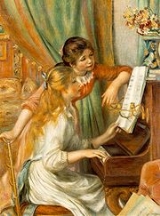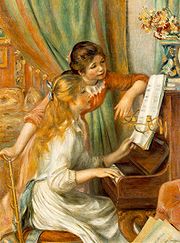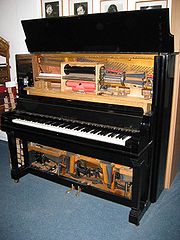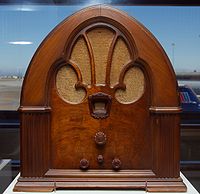
Social history of the piano
Encyclopedia

Social history
Social history, often called the new social history, is a branch of History that includes history of ordinary people and their strategies of coping with life. In its "golden age" it was a major growth field in the 1960s and 1970s among scholars, and still is well represented in history departments...
of the piano
Piano
The piano is a musical instrument played by means of a keyboard. It is one of the most popular instruments in the world. Widely used in classical and jazz music for solo performances, ensemble use, chamber music and accompaniment, the piano is also very popular as an aid to composing and rehearsal...
is the history of the instrument’s role in society. The piano was invented at the end of the 17th century, had become widespread in Western society by the end of the 18th, and is still widely played today.
Early years
At the time of its origin around the year 1700, the piano was a speculative invention, produced by the well-paid craftsman and inventor Bartolomeo CristoforiBartolomeo Cristofori
Bartolomeo Cristofori di Francesco was an Italian maker of musical instruments, generally regarded as the inventor of the piano.-Life:...
for his wealthy patron Ferdinando de Medici, Grand Prince of Florence
Florence
Florence is the capital city of the Italian region of Tuscany and of the province of Florence. It is the most populous city in Tuscany, with approximately 370,000 inhabitants, expanding to over 1.5 million in the metropolitan area....
. As such, it was an extremely expensive item. For some time after its invention, the piano was largely owned by royalty (e.g. the kings of Portugal
Portugal
Portugal , officially the Portuguese Republic is a country situated in southwestern Europe on the Iberian Peninsula. Portugal is the westernmost country of Europe, and is bordered by the Atlantic Ocean to the West and South and by Spain to the North and East. The Atlantic archipelagos of the...
and Prussia
Prussia
Prussia was a German kingdom and historic state originating out of the Duchy of Prussia and the Margraviate of Brandenburg. For centuries, the House of Hohenzollern ruled Prussia, successfully expanding its size by way of an unusually well-organized and effective army. Prussia shaped the history...
); see Fortepiano
Fortepiano
Fortepiano designates the early version of the piano, from its invention by the Italian instrument maker Bartolomeo Cristofori around 1700 up to the early 19th century. It was the instrument for which Haydn, Mozart, and the early Beethoven wrote their piano music...
for details. Even later on, (i.e. throughout the 18th and early 19th centuries), pianos were financially beyond the reach of most families, and the pianos of those times were generally the property of the gentry
Gentry
Gentry denotes "well-born and well-bred people" of high social class, especially in the past....
and the aristocracy
Aristocracy
Aristocracy , is a form of government in which a few elite citizens rule. The term derives from the Greek aristokratia, meaning "rule of the best". In origin in Ancient Greece, it was conceived of as rule by the best qualified citizens, and contrasted with monarchy...
. Visiting music masters taught their children to play the piano.
Pianos and women
Both Parakilas and Loesser emphasize a connection during this period between pianos and the female sex. Piano study was apparently more common for girls than boys. It was also widely felt that ability to play the piano made young women more marriageable.
Josiah Wedgwood
Josiah Wedgwood was an English potter, founder of the Wedgwood company, credited with the industrialization of the manufacture of pottery. A prominent abolitionist, Wedgwood is remembered for his "Am I Not A Man And A Brother?" anti-slavery medallion. He was a member of the Darwin–Wedgwood family...
, took piano lessons from none other than Frédéric Chopin
Frédéric Chopin
Frédéric François Chopin was a Polish composer and virtuoso pianist. He is considered one of the great masters of Romantic music and has been called "the poet of the piano"....
, and apparently achieved a fair level of proficiency. Following her marriage to Charles Darwin
Charles Darwin
Charles Robert Darwin FRS was an English naturalist. He established that all species of life have descended over time from common ancestry, and proposed the scientific theory that this branching pattern of evolution resulted from a process that he called natural selection.He published his theory...
, Emma still played the piano daily, while her husband listened appreciatively.
A number of female piano students became outright virtuose, and the skills of woman pianists inspired the work of Haydn, Mozart
Wolfgang Amadeus Mozart
Wolfgang Amadeus Mozart , baptismal name Johannes Chrysostomus Wolfgangus Theophilus Mozart , was a prolific and influential composer of the Classical era. He composed over 600 works, many acknowledged as pinnacles of symphonic, concertante, chamber, piano, operatic, and choral music...
, and Beethoven
Ludwig van Beethoven
Ludwig van Beethoven was a German composer and pianist. A crucial figure in the transition between the Classical and Romantic eras in Western art music, he remains one of the most famous and influential composers of all time.Born in Bonn, then the capital of the Electorate of Cologne and part of...
, who dedicated difficult-to-play works to their woman friends. However, careers as concert musicians were typically open only to men (an important exception was Clara Schumann
Clara Schumann
Clara Schumann was a German musician and composer, considered one of the most distinguished pianists of the Romantic era...
).
The spread of the piano
Over the course of the 19th and 20th centuries, the middle class of Europe and North America increased in both numbers and prosperity. This increase produced a corresponding rise in the domestic importance of the piano, as ever more families became able to afford pianos and piano instruction. The piano also became common in public institutions, such as schools, hotels, and public houses. As elements of the Western middle class lifestyle gradually spread to other nations, the piano became common in these nations as well, for example in Japan.To understand the rise of the piano among the middle class, it is helpful to remember that before mechanical and electronic reproduction, music was in fact performed on a daily basis by ordinary people. For instance, the working people of every nation generated a body of folk music
Folk music
Folk music is an English term encompassing both traditional folk music and contemporary folk music. The term originated in the 19th century. Traditional folk music has been defined in several ways: as music transmitted by mouth, as music of the lower classes, and as music with unknown composers....
, which was transmitted orally down through the generations and sung by all. The parents of Joseph Haydn (1732–1809) could not read music, yet Haydn’s father
Mathias Haydn
Matthias Haydn was the father of two famous composers, Joseph and Michael Haydn...
(who worked as a wheelwright) taught himself to play the harp, and the Haydn family frequently played and sang together. With rising prosperity, the many families that could now afford pianos and music adapted their home-grown musical abilities to the new instrument, and the piano became a major source of music in the home.
Amateur pianists in the home often kept track of the doings of the leading pianists and composers of their day. Professional virtuosi wrote books and methods for the study of piano playing, which sold widely. The virtuosi also prepared their own editions of classical works, which included detailed marks of tempo and expression to guide the amateur who wanted to use their playing as a model. (Today, students are usually encouraged to work from an Urtext edition
Urtext edition
An urtext edition of a work of classical music is a printed version intended to reproduce the original intention of the composer as exactly as possible, without any added or changed material...
.) The piano compositions of the great composers often sold well among amateurs, despite the fact that, starting with Beethoven, they were often far too hard for anyone but a trained virtuoso to play well. Evidently, the amateur pianists obtained satisfaction from coming to grips with the finest music, even if they could not perform it from start to finish.
A favorite form of musical recreation in the home was playing works for four-hand piano, in which the two players sit side by side at a single piano. These were frequently arrangements of orchestral works, and in the days before recordings served to spread knowledge of new orchestral music to places lacking an orchestra. Sometimes members of the household would sing or play other instruments along with the piano. This practice was often a part of courtship, for performing music together--particularly in the presence or at least earshot of other members of the household--was one of the few 'respectable' ways for a young man and young woman from 'good' families to be together.
Parents whose children showed unusual talent often pushed them toward professional careers, sometimes making great sacrifices to make this possible. Artur Schnabel
Artur Schnabel
Artur Schnabel was an Austrian classical pianist, who also composed and taught. Schnabel was known for his intellectual seriousness as a musician, avoiding pure technical bravura...
’s book My Life and Music vividly depicts his own experience along this lines, which took place in the Austro-Hungarian Empire in the late 19th century.
Decline

Player piano
A player piano is a self-playing piano, containing a pneumatic or electro-mechanical mechanism that operates the piano action via pre-programmed music perforated paper, or in rare instances, metallic rolls. The rise of the player piano grew with the rise of the mass-produced piano for the home in...
(ca. 1900), then the home phonograph
Phonograph
The phonograph record player, or gramophone is a device introduced in 1877 that has had continued common use for reproducing sound recordings, although when first developed, the phonograph was used to both record and reproduce sounds...
(which became common in the decade before World War I
World War I
World War I , which was predominantly called the World War or the Great War from its occurrence until 1939, and the First World War or World War I thereafter, was a major war centred in Europe that began on 28 July 1914 and lasted until 11 November 1918...
), then the radio
Radio
Radio is the transmission of signals through free space by modulation of electromagnetic waves with frequencies below those of visible light. Electromagnetic radiation travels by means of oscillating electromagnetic fields that pass through the air and the vacuum of space...
(in the 1920s) dealt severe blows to amateur piano-playing as a form of domestic recreation. During the Great Depression
Great Depression
The Great Depression was a severe worldwide economic depression in the decade preceding World War II. The timing of the Great Depression varied across nations, but in most countries it started in about 1929 and lasted until the late 1930s or early 1940s...
of the 1930s, piano sales dropped sharply, and many manufacturers went out of business.

Electronic keyboard
An electronic keyboard is an electronic or digital keyboard instrument.The major components of a typical modern electronic keyboard are:...
. This instrument, in its cheaper forms, is widely considered to provide only a poor substitute for the tonal quality of a good piano (see piano
Piano
The piano is a musical instrument played by means of a keyboard. It is one of the most popular instruments in the world. Widely used in classical and jazz music for solo performances, ensemble use, chamber music and accompaniment, the piano is also very popular as an aid to composing and rehearsal...
for why), but it is much more flexible and in many ways better suited to the performance of popular music
Popular music
Popular music belongs to any of a number of musical genres "having wide appeal" and is typically distributed to large audiences through the music industry. It stands in contrast to both art music and traditional music, which are typically disseminated academically or orally to smaller, local...
.
Nevertheless, the piano survives to this day in many 21st century homes. The pianos being bought today tend to be of higher quality and more expensive than those of several decades ago, suggesting perhaps that domestic piano playing may have concentrated itself in homes of wealthier or better-educated members of the middle class. It is unlikely that ability to play the piano contributes much these days to the marriageability of daughters, but many parents still feel today that piano lessons teach their children concentration and self-discipline, and open a door into the world of classical music
Classical music
Classical music is the art music produced in, or rooted in, the traditions of Western liturgical and secular music, encompassing a broad period from roughly the 11th century to present times...
.

